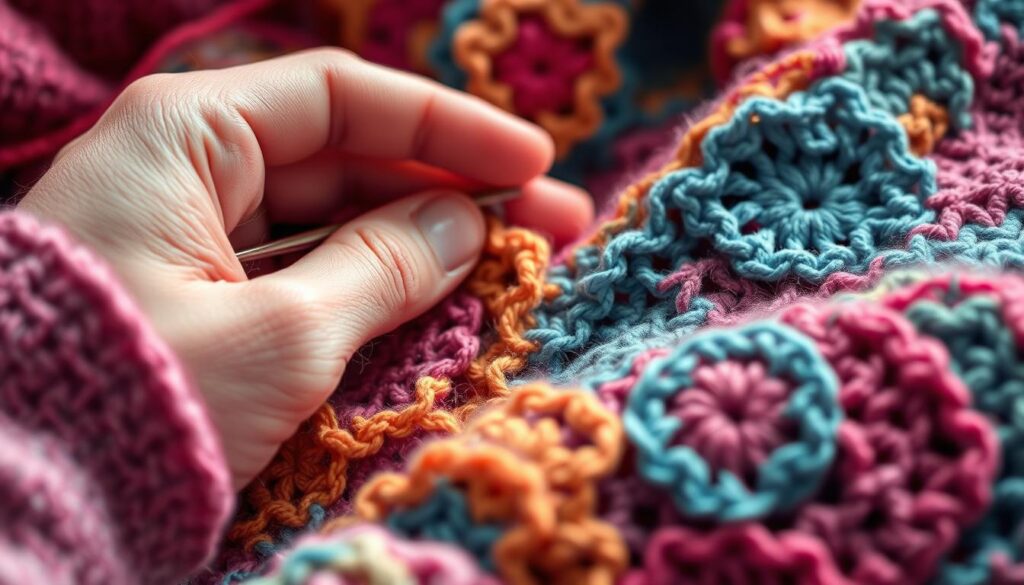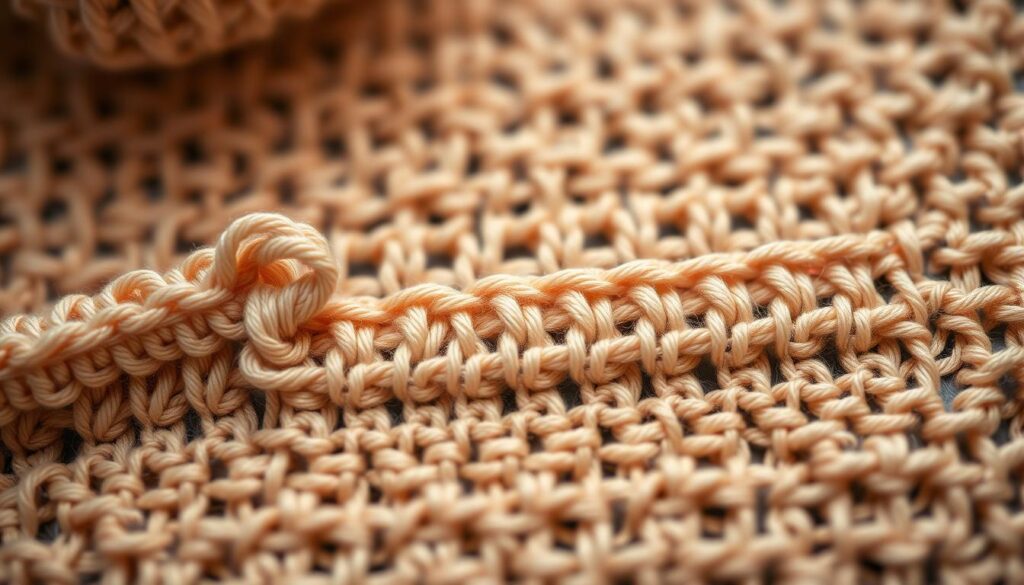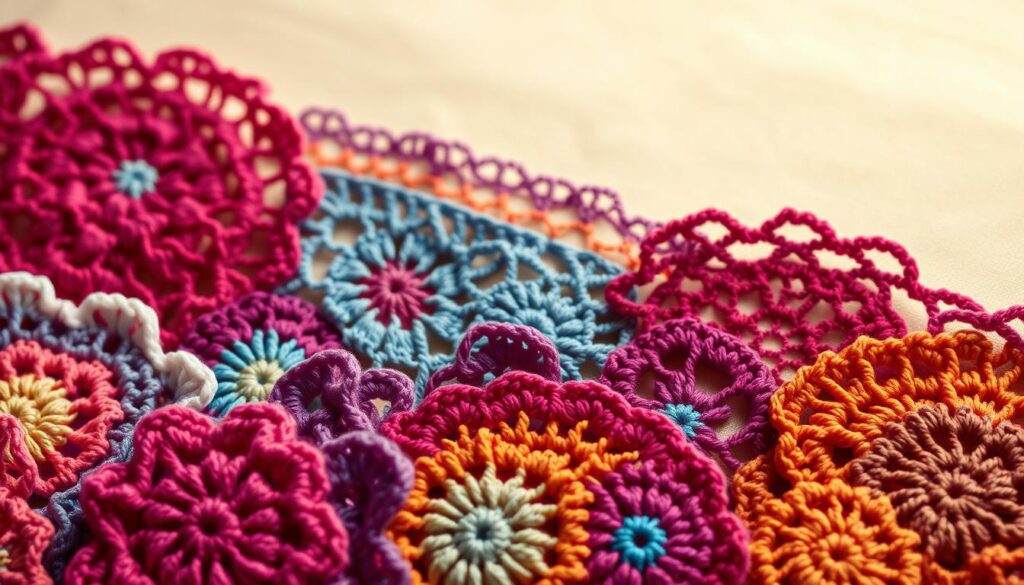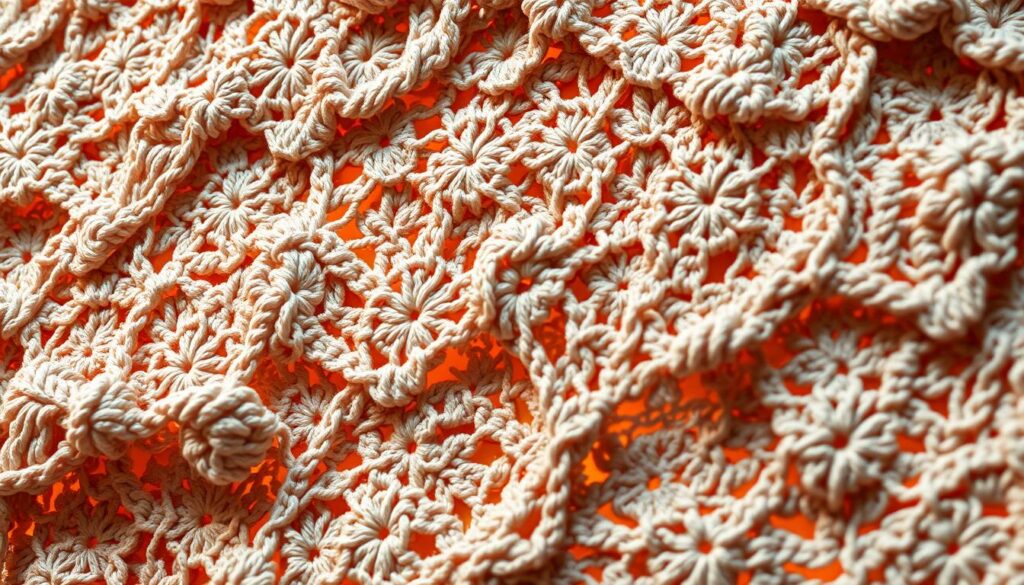When you start with crochet, learning new stitches is key. It helps you grow your skills and creativity. You can make unique designs with different stitches, adding texture and patterns to your work.
The variety of stitches lets you try out various techniques. You can start with simple stitches like the chain and single stitch. Then, you can move on to more complex ones, like the half double and double stitch.
With new stitches, you can make many projects. This includes blankets, scarves, amigurumi, and home decor. Online communities, video tutorials, and books like “Learn to Crochet in 10 Easy Lessons” can help you. They teach you the single crochet and more, taking you beyond the basics.
Key Takeaways
- Learning new crochet stitches can expand your skills and creativity
- A variety of crochet stitches can add texture and patterns to your projects
- The single crochet stitch is a foundational stitch that can lead to more complex stitches
- Online communities and video tutorials can provide support and guidance
- Mastering different crochet stitches can enhance the quality and appearance of your projects
- Crochet stitches can be used to create a wide range of projects, from beginner-friendly to complex designs
Why Learn New Stitches?
Learning new stitches can make your crochet projects stand out. It adds a unique touch that makes them special. By trying different stitches, you can tackle various projects, from simple to complex.
This variety lets you create items that are truly unique. It’s a great way to show off your skills and creativity.
Exploring new stitches can also bring texture and interest to your work. You might find yourself making intricate lace or bold, 3D designs. These can reflect your personal style and make your projects eye-catching.

Try stitches like broomstick lace crochet for a lacy look. Or, experiment with overlay crochet for a 3D effect. Mixing different stitches can lead to complex, visually appealing designs.
Learning new stitches is both fun and rewarding. It’s a great way to improve your crochet skills. With time and effort, you can master many stitches and create stunning, unique items.
Basic Crochet Stitches
Starting your crochet journey means learning the basic stitches. These include the single crochet, double crochet, half double crochet, and treble crochet. Mastering these stitches lets you tackle more complex projects. The single crochet, or “sc,” is a favorite for beginners. It makes a tight fabric, perfect for blankets and scarves.
The double crochet, or “dc,” is taller and creates a looser fabric. It’s great for projects like sweaters and hats. The half double crochet, or “hdc,” is versatile and works faster. It’s perfect for afghans and pillow covers.
Here are some key points to keep in mind when working with basic crochet stitches:
- Start with a foundation stitch, such as a chain stitch or a foundation single crochet, to create a stable base for your project.
- Use the correct hook size and yarn weight to ensure that your stitches are even and consistent.
- Practice, practice, practice! The more you crochet, the more comfortable you’ll become with the basic stitches.

Mastering basic stitches opens up a world of projects. From simple scarves to complex blankets, you can do it all. Always follow a pattern or tutorial. Don’t be afraid to try new things. With practice and patience, you’ll become a skilled crocheter.
| Stitch | Abbreviation | Description |
|---|---|---|
| Single Crochet | sc | A tight, versatile stitch perfect for blankets and scarves. |
| Double Crochet | dc | A taller stitch that creates a looser fabric, ideal for sweaters and hats. |
| Half Double Crochet | hdc | A fast and versatile stitch that falls between the single and double crochet in terms of height. |
Intermediate Crochet Stitches
As you get better at crochet, you’ll want to try more complex stitches. Stitches like the shell stitch and v-stitch are great for adding elegance to your projects. The shell stitch makes fan-shaped patterns, perfect for decorative edges. The v-stitch is great for making lace patterns.
Learning intermediate stitches means mastering treble crochet and working between sc and dc. This builds a strong foundation for your projects. With time and effort, you’ll get better at these stitches. This will help you make more detailed and beautiful projects.
Some key intermediate stitches to try include:
- Shell stitch: a fan-shaped stitch perfect for decorative edges
- V-stitch: a versatile stitch for creating lace patterns
- Popcorn stitch: a textured stitch that adds depth and interest to your work

Using these stitches in your projects can make them stand out. They’re great for creating airy fabric, intricate lace, or decorative edges. Intermediate stitches help you reach new heights in your crochet skills.
| Stitch | Description |
|---|---|
| Shell Stitch | A fan-shaped stitch perfect for decorative edges |
| V-Stitch | A versatile stitch for creating lace patterns |
| Popcorn Stitch | A textured stitch that adds depth and interest to your work |
Exploring Advanced Stitches (Optional)
If you’re an experienced crocheter, you might want to try more complex stitches. Stitches like tunisian crochet need a special hook and a unique technique. They make stunning, dense fabrics with grid patterns. These stitches are great for showing off your skills and creativity in unique projects.
Exploring advanced stitches lets you make openwork designs, dense fabrics, and intricate patterns. With the right tools and practice, you can make everything from delicate lace shawls to complex afghans. To start, you’ll need a special hook and some patience, as these stitches can be tricky.
Here are some tips for starting with advanced stitches:
- Begin with simple projects like scarves or hats to practice and build confidence.
- Use online tutorials and videos to learn new stitches and techniques.
- Join a crochet community or find a crochet buddy for support and motivation.

With practice and patience, you can master advanced stitches. You’ll be able to make beautiful, intricate projects that show off your skills and creativity. Whether you’re aiming for a stunning afghan or a delicate lace shawl, advanced stitches can elevate your crochet.
| Stitch | Description | Level |
|---|---|---|
| Tunisian Crochet | A type of crochet that uses a special hook to create dense, grid-based fabric. | Advanced |
| Filet Crochet | A type of crochet that uses a special hook to create intricate, openwork designs. | Advanced |
Practice and Experimentation
As you keep going on your crochet journey, practice and experimentation are key. Making stitch samples and swatches lets you try new stitches. You’ll see how different yarns and hooks work together.
Online, you can find lots of help. There are online tutorials, video tutorials, crochet books, blogs, websites, and youtube channels. They help you get better. It’s all about having fun and trying new things.
Creating Stitch Samples
When making stitch samples, follow a consistent method. Begin with a foundation chain, then do a specific stitch pattern. This shows you how the stitch works with different yarns and hooks.
Finding Tutorials and Resources
There are many ways to learn new stitches and techniques. Online tutorials and video tutorials guide you step by step. Crochet books and blogs are full of info and ideas. You can also join online groups to meet other crocheters and share tips.
Incorporating New Stitches into Projects
Once you’ve learned the basics and tried many crochet stitches, it’s time to use them in your projects. You can make blankets, scarves, shawls, amigurumi, or home decor items. Mixing different stitches and techniques lets you create unique pieces.
Stitch dictionaries and online resources can help you mix stitches in new ways. This lets you design patterns that show your style. Crochet is all about expressing yourself, and learning new stitches opens up a world of possibilities.
By using many techniques in your projects, you can make items that are truly yours. Don’t be scared to try new things. Crochet offers endless chances to show your creativity.

